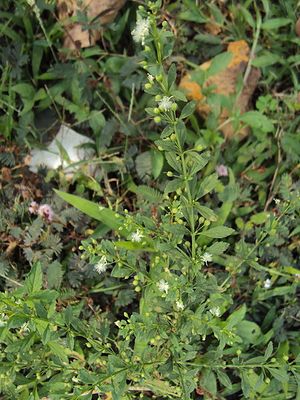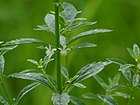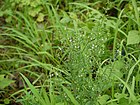Note: This is a project under development. The articles on this wiki are just being initiated and broadly incomplete. You can Help creating new pages.
Scoparia dulcis - Sweet Broom Weed
Scoparia dulcis is a species of flowering plant in the plantain family and It is native to the Neotropics but it can be found throughout the tropical and subtropical world.
Contents
- 1 Uses
- 2 Parts Used
- 3 Chemical Composition
- 4 Common names
- 5 Properties
- 6 Habit
- 7 Identification
- 8 List of Ayurvedic medicine in which the herb is used
- 9 Where to get the saplings
- 10 Mode of Propagation
- 11 How to plant/cultivate
- 12 Commonly seen growing in areas
- 13 Photo Gallery
- 14 References
- 15 External Links
Uses
gastralgia, dysentery, intestinal affections, fever, enteritis, beriberi, edema, Diarrhea, coughs, kidney complaintss, indigestion, colic.
Parts Used
Chemical Composition
Palmitic acid, b-sitosterol, glutinol, and a mixture of b-amyrin and isomultiflorenol[1]
Common names
| Language | Common name |
|---|---|
| Kannada | |
| Hindi | Mithi patti |
| Malayalam | |
| Tamil | Sarakkotthini |
| Telugu | |
| Marathi | NA |
| Gujarathi | NA |
| Punjabi | NA |
| Kashmiri | NA |
| Sanskrit | |
| English | Sweet Broom Weed, Sweet Broom Wort |
Properties
Reference: Dravya - Substance, Rasa - Taste, Guna - Qualities, Veerya - Potency, Vipaka - Post-digesion effect, Karma - Pharmacological activity, Prabhava - Therepeutics.
Dravya
Rasa
Tikta (Bitter), Kashaya (Astringent)
Guna
Laghu (Light), Ruksha (Dry), Tikshna (Sharp)
Veerya
Ushna (Hot)
Vipaka
Katu (Pungent)
Karma
Kapha, Vata
Prabhava
Habit
Identification
Leaf
| Kind | Shape | Feature |
|---|---|---|
| Simple | Oblong-elliptic | Leaf Arrangement is Decussate or whorled |
Flower
| Type | Size | Color and composition | Stamen | More information |
|---|---|---|---|---|
| Unisexual | 2-4cm long | white | 5 | Flowers are Solitary or 2, axillary and Flowering throughout the year |
Fruit
| Type | Size | Mass | Appearance | Seeds | More information |
|---|---|---|---|---|---|
| ellipsoid | 7–10 mm | Fruit are globose capsule and Fruiting throughout the year | septicidal, reticulate | 4 | {{{6}}} |
Other features
List of Ayurvedic medicine in which the herb is used
- Vishatinduka Taila as root juice extract
Where to get the saplings
Mode of Propagation
How to plant/cultivate
A common weed of lowland tropical and subtropical areas, found in areas where it rains all year round and also where there is a prolonged dry season[310 ]. Succeeds in most soils[3]
Commonly seen growing in areas
Photo Gallery
References
External Links
- Ayurvedic Herbs known to be helpful to treat gastralgia
- Ayurvedic Herbs known to be helpful to treat dysentery
- Ayurvedic Herbs known to be helpful to treat intestinal affections
- Ayurvedic Herbs known to be helpful to treat fever
- Ayurvedic Herbs known to be helpful to treat enteritis
- Ayurvedic Herbs known to be helpful to treat beriberi
- Ayurvedic Herbs known to be helpful to treat edema
- Ayurvedic Herbs known to be helpful to treat Diarrhea
- Ayurvedic Herbs known to be helpful to treat coughs
- Ayurvedic Herbs known to be helpful to treat kidney complaintss
- Ayurvedic Herbs known to be helpful to treat indigestion
- Ayurvedic Herbs known to be helpful to treat colic
- Herbs with Seeds used in medicine
- Herbs with common name in Hindi
- Herbs with common name in Tamil
- Herbs with common name in English
- Habit - Annual plantHerb
- Index of Plants which can be propagated by Seeds
- Herbs that are commonly seen in the region of Subtropical
- Herbs that are commonly seen in the region of Tropical
- Herbs





